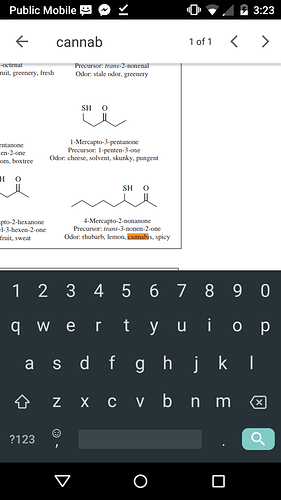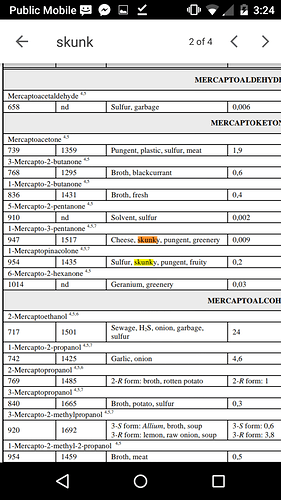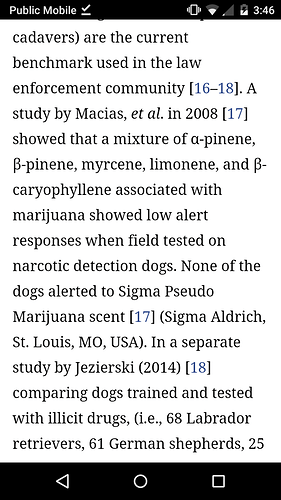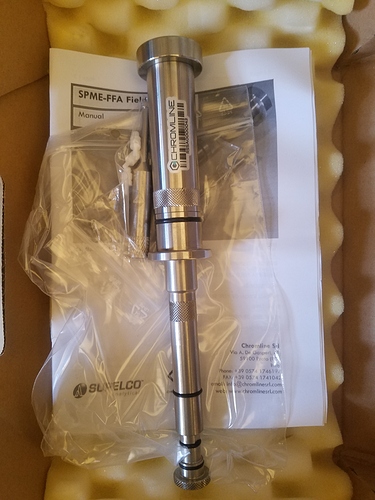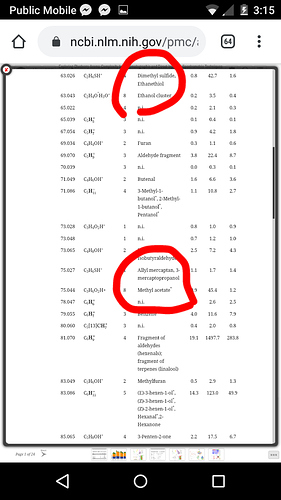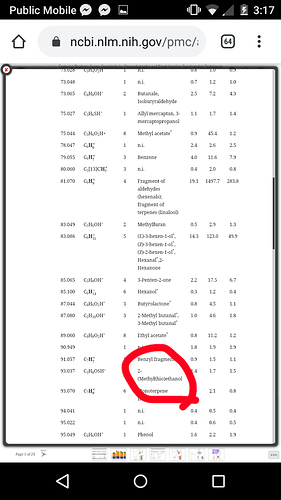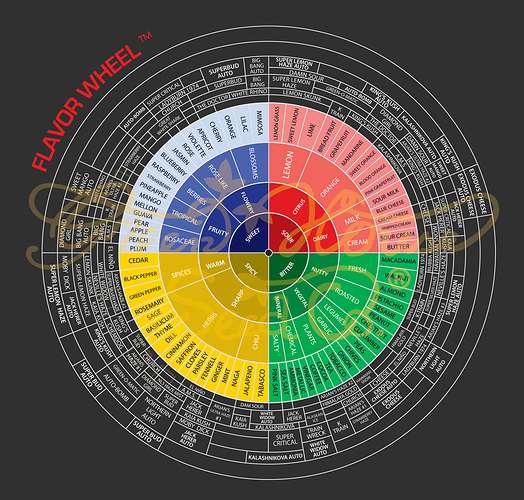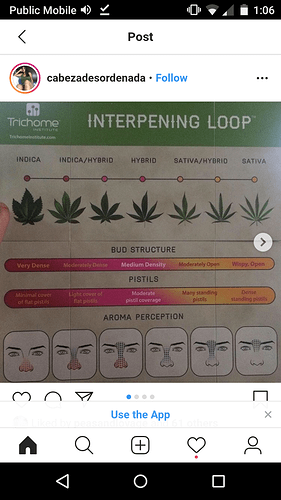I bought two brands of skunk spray off Amazon. They are meant for covering hunters smell. They both smell like sesame. They both label “butanethiol” as the active ingredient, I’m sure there is a carrier oil. Good scents website labels pure butanethiol as “white sesame flavor” it’s not the one you want. But the best way to find out is to purchase some for yourself if you don’t believe me. It smells like a Panda Express
@Krative
I’m going to make a list of possible candidates why I think they are candidates, and components that have been tested in cannabis but aren’t directly described as skunky.
Possible candidates:
•1-butanethiol (described as skunky by some, fairly common)
•methyl mercaptan (funky thiol, tested positive in cannabis with packaging, but possibly from plastic packaging?)
• 4-Mercaptononan-2-one/4-mercapto-2-nonanone (thiol w/described “cannabis” odor)
•1-Mercaptopinacolone (sulfur, skunky, pungent, fruity)
•1-Mercapto-3-pentanone (cheesy, skunky, pungent, grennery, solvent)
•3-Methyl-2-buten-1-thiol (Aged beer, hop, skunky, pungent)
Known cannabis components that are funky/sulfurous:
•dimethylsulfide (corn, cabbage, slightly skunklike)
•myrcene (described in correlation, uncited literature, but studies show major terpenes including myrcene dont trigger drug smelling dogs)
•∆-3-carene (sweet, musky, pungent)
Random mercaptan photos and examples from
https://www.google.com/url?sa=t&source=web&rct=j&url=https://www.ncbi.nlm.nih.gov/m/pubmed/17017878&ved=2ahUKEwjp6OjC8I3mAhXtRt8KHSkHBy8QFjABegQIAhAB&usg=AOvVaw349fip5MyuyxFSR8uJp_og
I know there are more good candidates and I will add more later, have to do other things for now.
Yes, it’s associated with sesame smell and is one of the primary smell components of sesame. Often poor extractions can carry smells of the source. Most botanical terpenes I have smelled had variance in smell obviously coming from the different source it is derived from. Beta caryophyllene might smell more like black pepper or cloves depending on which source it was extracted from. Synthetic butanethiol might be a better representative though you may need to do digging to find it. Either way it is still a candidate to me as I’m not looking to recreate the smell, but rather to understand and identify it.
I have a Solid Phase MicroExtraction field sampler and variety of applicable adsorbents.
A few yrs ago, i coordinated a research project for a client, we contracted Pixis for this work, and got way deep in the weeds with data, a whole lota data LOL!. It turned out to be an expensive endeavour with no guarantees to make the client confident their investment would yield data they could use to make profit. ! (Shitty how some think “science” guarantees insights you can make $$ off of)
This research could be a great opportunity for a f42K community driven project. Im down to support with my resources.
I also got some dynamic and static headspace sample chambers for use on live plants I need to dig outa the lab.
I’m interested in your data.
Commercial Butanethiol is formed by the reaction of n-butylene with hydrogen sulfide in the presence of a catalyst. The United States purchases over 1 million lbs of it a year (high volume chemical classification) they aren’t extracting it from sesame oil. It smells like food, it doesn’t smell like weed, even when combined with terpenes, including myrcene. But feel free to put it on the top of your list, buy it and smell it for yourself. Your whole house will smell like panda express. Google isn’t going to smell for you.
All the mercaptan related compounds I could get my hands on also weren’t right but I think it’s a massive category.
I also had high hopes for butanethiol as an easy way of getting the skunky dimension into terp blends but alas it is not the right sulfur compound and not close enough to mimic it. Had a lot of people smell it and they all thought “food” “gross food” i tried many concentrations. It’s a really common food flavor additive. It has a definite umami going on but not gas skunk. Im curious to hear if anyone else has tried experimenting first hand with different thiols.
Myrcene isn’t gassy though. Just smells like beer hops. @peasandlovage is right, the answer to the funk puzzle has got to be some other unidentified flying organic compound.
I can chime in on this one. No one ever should handle these chemicals in their pure, undiluted form. Simple as that. There are some natural and synthetic thiols that are considered “food grade” but they are absolutely nothing like any terpene isolate out there. You will regret even opening the bottle just once. I can’t stress this enough when I say that high purity thiols are hands down the strongest and most noxious chemicals I have ever encountered in my life. Another terpene company showed me some samples and I was actually concerned that they were handling this stuff, let alone even considering using it. These are the types of chemicals where doing as little as untwisting the threads on the vial would leave any well-ventilated lab smelling like rotten eggs and sweaty gym clothes for the rest of the week. I don’t think any fume hood or ventilation system could compete with handling these chemicals. If someone dropped even a tiny glass vial of it they would need to evacuate.
yeah we should all be hoping it isnt thiols
I had some gas station come back at 18% myrcene and it wasn’t skunky. It was like a petrol, rubber, gas smell. Kind of similar to a tire fire almost had a little leather smell but I wouldn’t classify myrcene as skunky.
Interesting. I’ll have to dig up some of my test results to compare
Update: I think I’m mixing up my “gassy” with my “skunky”
Yea, for each area of the flavor wheel, we have our work cut out for us to determine what is contributing to each distinctly perceivable flavor/fragrance.
Below are the 3 areas of the cannabis plant’s formulary thats been evading me for yrs, I would love to hash these out so. These “dimensions” may be totally related or not. My hypothesis is each “dimension” is the result of a grouping of odorants, and not from a single compound.
1)The Skunk (roadkill, babyshjt, very tenacious, and loud)
2) The Gas ( that “diesel” )
3) The Funk (that undeniable “who’s smokin’ pot!” The note that even the bricked up schwag has when burned. The smell on your clothes hrs after standing near an open pot of Decarbing crude)
#1 is a rare find for me these days, Anytime i go into dispensary I ask, smell and havent had seen the loud skunk in yrs. Maybe its thiols, maybe its not. Perfumers formulate all kinds of fragrance experiences, creating synergies b/t the mixtures components.
#2 could be created from a group of compounds with a high diffusivity and may have some overlapping odorants in common with other notes not mentioned here (kush, cheese, etc)
#3 however seems to be created from heavier components (may also be in part due to degradation of the mixture’s components) and seems to me these compounds could be found in multiple flavors of cannabis
These three notes I see as the primary “dimensions” that are missing from all botanical terp blends trying to replicate cannabis flavors.
Have gotten some interesting fractions from cold trapping vacuum oven while purging sauces and decarbing bho. All were “one-dimensional”, some tasted/smelled exactly like some botanical derived terps blends. Other “fractions” weve caught tasted like CK mens cologne, coffee etc LOL (nothing like cannabis I’d smoke)
Maybe the coffee fraction you were smelling was Furfuryl mercaptan? Or closely related @CollectiveObjective
@MediumTroy That was a list for @Krative or anyone else to possibly test for, not a list of things I want to smell isolated ![]() . I would not ever attempt to smell a concentrated thiol… @qma warned me away from that months ago and the more I looked into it the more i knew he was right. If you want a cheap skunky fix you can literally buy undiluted skunk “essence” literally just skunk spray taken from skunks in a bottle for fairly cheap. Hunters use it to mask smells also. I would never use even that personally except maybe as a very mean prank haha. But really it can be considered a biological weapon at that point. It has been used as a weapon before actually. I’m not going to get into that too much, again, not the point of my endeavour but its good that people are aware of this.
. I would not ever attempt to smell a concentrated thiol… @qma warned me away from that months ago and the more I looked into it the more i knew he was right. If you want a cheap skunky fix you can literally buy undiluted skunk “essence” literally just skunk spray taken from skunks in a bottle for fairly cheap. Hunters use it to mask smells also. I would never use even that personally except maybe as a very mean prank haha. But really it can be considered a biological weapon at that point. It has been used as a weapon before actually. I’m not going to get into that too much, again, not the point of my endeavour but its good that people are aware of this.
Some random research today showed me a couple things.
#1 I found a really good rks thread on icmag
Great read for those interested in skunky cannabis. Sam the skunkman chimes in.
#2 in this search I found a breeding company (AlphaKronik) www.alphakronik.com who is specifically talking about breeding for thiol content. Their words: " The Darkside Series by Alphakronik Genes is an expression of what is possible when breeding for extreme Thiol production and heavy Terpenes. Thiols are the contrasting flavonoid found within the Cannabis species that makes up the stinky smells throughout nature. Garlic, Fuel, Skunk, Gas, Onion, and Feces smells all come from Thiols rather than Terpenes. Thiols are a carbon chain with a sulfur atom connected at the end of the chain rather than an oxygen atom as found in Terpenes. They are used in the Cannabis plant to attract bugs to catch in their sticky traps (trichomes). They then use drop the dead prey to the ground and use the symbiotic relationship with the soil to feed itself. Alphakronik Genes is proud to be the first breeding team in the world to focus on such focused research, and are now proud to introduce a series dedicated to the “stink” factor found within Cannabis, and are working to develop new research models to advance scientific discoveries throughout the Cannabis genome."
(I’m Thesearch on icmag)
#3 I was looking up what makes blueberries smell and taste like they do (Exploring Blueberry Aroma Complexity by Chromatographic and Direct-Injection Spectrometric Techniques - PMC) in hopes to lend info to someone curious about what makes cannabis smell like a blueberry and found this incredibly interesting study on this, and also on a different form of analysis equipment then I have heard of personally [PTR-ToF-MS (proton transfer reaction-time of flight-mass spectrometry)]. What struck me, and is relevant to this thread, is that with the non-gcms analysis they did (they did a spme-gc-ms as well) they found several thiols. In blueberries. So I am hard pressed to explain both how they were not detected on the spmegcms and how there could possibly not be thiols in cannabis if there are in blueberries… More and more I am thinking that gcms may not really be appropriate for finding thiols or really even the full breadth of what makes cannabis smell and taste the way it does.
From the study “Characterizing the Smell of Marijuana by Odor Impact of Volatile Compounds” Characterizing the Smell of Marijuana by Odor Impact of Volatile Compounds: An Application of Simultaneous Chemical and Sensory Analysis - PMC
"9% of the chemicals detected by MS had an associated aroma, 75% of the chemicals detected did not have an aroma detected, and 16% registered low or no chemical signal but an aroma was detected. "
I’ve had a couple in the last years that were strong enough that everyone around me knew what was up. Pink Panther and Monster Cookies stood out. There are a huge variety of thiols that range from fruity to skunky and all sorts of funk in between. I think #1 & #2 are related, #3 is tricky. Sometimes in the fall in canada people burn their leaves instead of composting or having them taken away, and the smell of a burning pile of maple leaves is distinctly similar to weed being smoked, particularly shit brick weed/weed leaves spicy burning smell.
Also for fun here’s a little article on different thiols
https://www.sciencedirect.com/topics/agricultural-and-biological-sciences/ethanethiol
I agree with you in that 1 and 2 could be related. I imagine many of the dominant notes could have components that are partially overlapping.
This flavor wheel from greenhouse seeds has enticed me for a few yrs. Seems to be the only comprehensive descriptive ordering of the flavors we experience in canna. It could be a simple rip of a coffee, wine or cheese flavor wheels. I’m not sure.
This paper from Justin Fischedick (badass) is a good one that may help us in our classification efforts. (This paper is likelyalready in the data dump.)
Identification-of-Terpenoid-Chemotypes-Among-High-−-trans-Δ9-Tetrahydrocannabinol-Producing-Cannabis-sativa-L.-Cultivars-Cannabis-Research-for-Cannabinoid-Safety.pdf (824.4 KB)
Is that a thiol found in coffee? My friend damaged his sense of smell from doing a bad batch of ketamine and couldnt distinguish between a fart, coffee or dank kush. He got them mixed up a lot after.
@CollectiveObjective I have always not liked yhat flavour wheel. Like, isnt vinegar sour not bitter? Those herbs are not sharp either. Imo its just a bs way to convince people to buy their chemical coated seeds. Sweet, sour, bitter and salty is the list of four tongue senses, spicy is not really a taste as much as a burning of taste buds haha, and almost every single flavour from cannabis is actually sensed by your nose, not your tongue. Try some dank weed and plug your nose while you toke. All you will taste is bitter. Personally, I think a better way of organizing is like this picture I found on ig.
I identify with the picture because I find a frequency of smells from low (earthy, sulfury, nutty) to high (citrus, sour, bright) and this almost always correlates with sedative or uplifting effects. When you smell a high pitch smell it hits quick, can be described as sharp and is sensed the moment it hits your nostril, where as with earthy tones it actually helps to smell them by slowing down your inhalation like you’re trying to smell the moss in a forest and is perceived higher up in the nose. Now, all of that is anecdotal so I’m not saying it is 100% true, but it’s how I experience it.
Also I heard Kanye likes that guy. JS
Reading now about the reactions of thiols with flavanoids, especially quinones. Interesting research. Will add a quinone thiol to the list soon. Seems promising.
Thiols have been a hot topic in the beer/hops world for a few years. Below is a quot from a review article on hop aroma that gives a good overview. There is also interest in thiols in the wine world as well. Hopefully that helps in your method development.
Sulfur compounds
Hops contain various sulfur compounds. These include methyl thioesters,[97,98] thiophenes,[99] methyl- or polysulfides,[97,100] polyfunctional thiols,[101,102] and also sulfur adducts of myrcene (myrcene disulfide), α-humulene, or β-caryophyllene.[99] The complexity of sulfur containing compounds in hops and beer is huge.[103] In some varieties, such as the New Zealand grown Nelson Sauvin hops and particularly U.S. grown Cascade, Citra, Simcoe, and Tomahawk, polyfunctional thiols were reported as key contributors to the specific aroma of those varieties.[104,105] Compared to the oxygenated compounds (thus far), a minimal amount of research has been performed to study the relevance of sulfur compounds. Obviously, this is due to the complexity of their analysis and extremely low concentration (ng/L), rather than their insignificance. The work in this field of aroma research is ongoing and might surely be regarded as one of the hottest current topics. Although terpenes and terpenoids are absolutely regarded as positive (beer) flavorings, most sulfur compounds are detrimental to the quality of fresh beers.[17] The human olfactory system is sensitive to sulfur compounds, and, thus, they tend to have low thresholds (ng/L or ppt).[22,106] Depending on their chemical structure, they exhibit cheesy, cooked vegetable-like, burnt, musty, and rubbery odors. However, there are also some sulfanyl esters, sulfur containing alcohols, and ketones that exhibit fruity, citrus, blackcurrant, peach, or muscat-like odors.[102] Thus far, the most relevant sulfur compound contributing (positively) to hoppy beer flavor is 4-mercapto-4-methylpentan-2-one (4MMP). It was shown that 10 ng/L spiking was sufficient to emphasize the fresh and fruity aroma of lager beer.[107] Its typical fruity blackcurrant flavor is a key characteristic of beers hopped with U.S. grown Cascade, Simcoe, Summit, and Apollo.[102]
